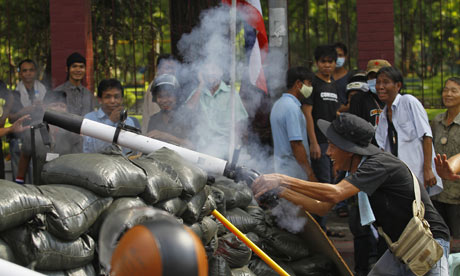Q&A: Who and what is causing the Thailand confrontation?
Ben Doherty and Sam Jones
guardian.co.uk, Friday 14 May 2010 13.21 BST
Redshirts, yellowshirts and the background to the violence in Bangkok
 An anti-government protester fires a homemade rocket during the occupation of the business district in Bangkok, Thailand. Photograph: Ahmad Yusni/EPA
What are the origins of this confrontation?
An anti-government protester fires a homemade rocket during the occupation of the business district in Bangkok, Thailand. Photograph: Ahmad Yusni/EPA
What are the origins of this confrontation?
Put simply, Thailand's rural poor are protesting for the right to have a greater say in the government of their country. The move is being resisted by the Bangkok elite " the wealthiest families, the military, the bureaucrats " who have controlled Thailand's affairs for generations.
Although the issue is complicated by the influence of people such as the former prime minister Thaksin Shinawatra, at the heart of the conflict lies a struggle for, or a defence of, a greater say in the running of the country.
Who are the redshirts?
The redshirts are drawn largely from Thailand's rural poor, mainly from the north and north-east of the country. They are the electoral majority. Many are still supporters of the fugitive Thaksin. Although their movement grew out of a loyalty to Thaksin, it has become broader than him, with its leaders claiming their campaign is about bringing a more representative democracy to Thailand.
While Thaksin's face is still on much of their monochromatic merchandise and his billions are still bankrolling many protests, he does not appear by videolink very often anymore " nor is he mentioned by the leaders in their speeches very much. The movement has now begun to draw in city students and members of Bangkok's burgeoning elite.
They regard the current government as illegitimate because it never won an election and was brought to power by a parliamentary election " engineered by the military " after the redshirts' party was dissolved for electoral fraud and kicked out of parliament.
Who is pulling the strings?
The redshirts are an informal movement, with no real leadership structure or chain of command. Their leaders are an eclectic lot. They include:
Weng Tojirakarn " a medical doctor and former member of the communist party, he is one of the most eloquent of the redshirt leaders.
Veera Musikapong " former member Thaksin's Thai Rak Thai (Thais love Thais) party, which was dissolved. He helped set up the redshirts on TV channel People TV.
Arisman Pongruangrong " a 1980s pop star-cum-political activist, he famously avoided arrest during these protests by escaping from a Bangkok hotel, climbing out the window and down a rope ladder.
Seh Daeng " Renegade army major general, also known as Khattiya Sawasdipol, who headed the redshirts' paramilitary arm the black-clad "guards". Accused by the government of ordering grenade attacks all over Bangkok, he was shot by a sniper yesterday and remains in a coma in hospital.
Who are the yellowshirts?
The yellowshirts, or People's Alliance for Democracy, are the reds' opposition. They represent the ruling class in Bangkok, known as the amataya, or elite. They are the wealthy families, the military and the bureaucrats, who have long exerted a huge influence on Thai politics.
They wear yellow because they claim also to represent the interests of the monarchy (yellow being the Thai king's "colour"). In 2008 they seized both the airport and government house, but in this current standoff, the yellowshirts are nowhere. They flirted with the periphery of this current impasse, but have never become significantly involved.
What are the chances of a compromise solution?
At the beginning of this week, the chances looked good; the government had offered the redshirts an early election in November and the reds had said they agreed "in principle" to the "reconciliation roadmap" offered by the prime minister. But negotiations foundered over demands from the reds that Thailand's deputy prime minister be arrested for ordering troops to move on protesters on 10 April, when 25 people were killed.
The government then withdrew the offer of an early poll, and sent troops in to surround the protesters, cutting off their supplies of food, water, electricity, and fuel. Violence broke out again, and the two sides are now as far apart as they have been for this entire two-month political standoff.
Does Thailand have a history of political violence and uncertainty?
Most definitely. The current Thai king, who is 83, has sat on the throne for 63 years, during which time he has witnessed more than 15 coups, 16 constitutions and 27 changes of prime minister. Although the current bloodshed is the worst in two decades, it is not unprecedented: Thai democracy has been unstable for generations.